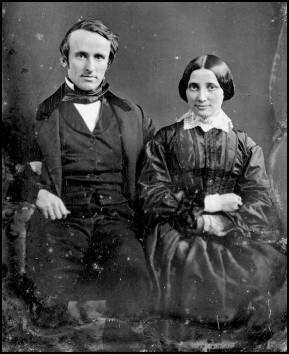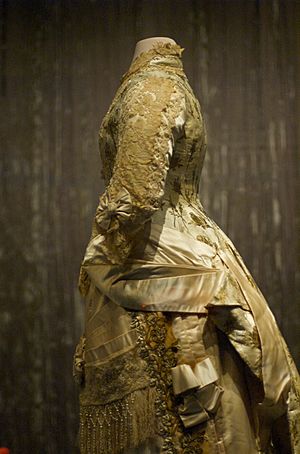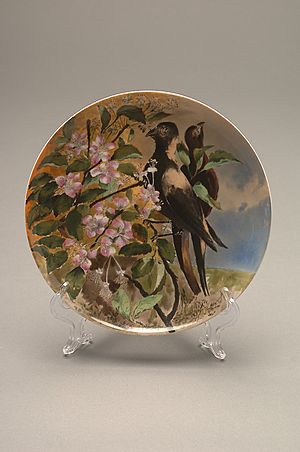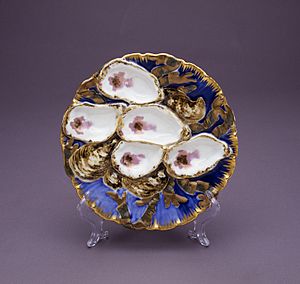Lucy Webb Hayes facts for kids
Quick facts for kids
Lucy Webb Hayes
|
|
|---|---|
 |
|
| First Lady of the United States | |
| In role March 4, 1877 – March 4, 1881 |
|
| President | Rutherford B. Hayes |
| Preceded by | Julia Grant |
| Succeeded by | Lucretia Garfield |
| Personal details | |
| Born |
Lucy Ware Webb
August 28, 1831 Chillicothe, Ohio, U.S. |
| Died | June 25, 1889 (aged 57) Fremont, Ohio, U.S. |
| Resting place | Spiegel Grove |
| Spouse | |
| Children | 8, including Webb and Rutherford |
| Education | Ohio Wesleyan University (BA) |
| Signature | |
Lucy Ware Hayes (born Webb; August 28, 1831 – June 25, 1889) was the wife of President Rutherford B. Hayes. She served as the First Lady of the United States from 1877 to 1881. The First Lady is the title given to the wife of the President of the United States.
Lucy Hayes was the first First Lady to have a college degree. She was also very welcoming to all guests. Lucy supported African Americans before and after the American Civil War. She even invited the first African-American professional musician to perform at the White House.
Historians later called her "Lemonade Lucy" because she strongly supported the idea of not drinking alcohol. However, people did not use this nickname when she was alive. It was actually her husband, President Hayes, who decided to ban alcohol from the White House.
Contents
Early Life and Family
Lucy Webb was born on August 28, 1831, in Chillicothe, Ohio. Her parents were Dr. James Webb and Maria Cook. She had two older brothers who both became doctors.
In 1833, Lucy's father went to Lexington, Kentucky. He wanted to free 15-20 enslaved people he had received from his aunt. A serious sickness called cholera was spreading at that time. James cared for the sick but then became ill with cholera and died.
Friends told Lucy's mother, Maria, to sell the enslaved people instead of freeing them. Maria bravely said she would rather wash clothes to earn money than sell anyone. Maria's father, Isaac Cook, believed people should not drink alcohol. He encouraged young Lucy to promise she would not drink alcohol. The Webb family were Methodists.
Lucy's Education
In 1844, Lucy's family moved to Delaware, Ohio. Her brothers went to Ohio Wesleyan University. Women were not usually allowed to study there. But Lucy was allowed to join the college preparation program. A report from 1845 said her behavior was "beyond reproach," meaning it was excellent.
A few months later, Lucy moved to Cincinnati Wesleyan Female College. She graduated from there in 1850. Lucy had a much better education than most young women of her time.
While in college, Lucy wrote essays about social and religious topics. One essay was about whether traveling on Sundays was right for Christians. At her graduation, she read an essay called "The Influence of Christianity on National Prosperity." Lucy seemed to be interested in the women's suffrage movement, which was about women's right to vote. She wrote that a woman's mind is as strong as a man's. She believed women should be seen as equal to men.
Marriage and Family Life
Lucy first met Rutherford B. Hayes at Ohio Wesleyan University. Lucy was 14, and Rutherford was 23. Rutherford's mother hoped they would connect. But Rutherford thought Lucy was "not quite old enough to fall in love with" yet.
In 1850, Rutherford's older sister, Fanny Platt, encouraged him to visit Lucy again. That summer, Lucy was 19. She and Rutherford were both in the same wedding party. Rutherford was so impressed with Lucy that he gave her a gold ring he found in the wedding cake.
In 1851, Rutherford wrote in his diary about how much he loved Lucy. He admired her voice, her eyes, and her intelligence. He called her "a genuine woman." After they got engaged, Lucy gave the wedding cake ring back to Rutherford. He wore that ring for the rest of his life.
Lucy and Rutherford were married at her mother's house in Cincinnati. It was a simple ceremony on December 30, 1852. They spent their honeymoon at Fanny's house in Columbus, Ohio. While there, Lucy and Fanny became close friends. They went to lectures and concerts together. They even heard a speech by Lucy Stone, a famous supporter of women's rights. Lucy Hayes agreed that women should be paid fairly.
The couple had eight children: Birchard Austin (1853–1926), Webb Cook (1856–1934), Rutherford Platt (1858–1927), Joseph Thompson (1861–1863), George Crook (1864–1866), Fanny (1867–1950), Scott Russell (1871–1923), and Manning Force (1873–1874).
Lucy's strong feelings against slavery influenced Rutherford. After they married, Rutherford began defending runaway slaves in court. These enslaved people had escaped into Ohio from Kentucky.
Civil War Contributions
When news of the attack on Fort Sumter reached Cincinnati, Lucy strongly supported the war. She felt that if she had been there, there would not have been a surrender. Her passion encouraged Rutherford to join the army as a major.
Lucy often visited Rutherford in the field, sometimes with her mother and children. She helped her brother, Dr. Joe Webb, care for sick soldiers. In September 1862, Rutherford was hurt in battle. Lucy quickly found him and helped him recover.
After Rutherford returned to his army group, Lucy became a regular visitor at his camp. She helped the wounded, cheered up homesick soldiers, and comforted those who were dying. She also got supplies from people in the North to help the Union soldiers. The soldiers of the 23rd Ohio Volunteer Infantry lovingly called her "Mother Lucy" because of her kindness and help.
Life in Congress and Ohio
When Rutherford served in Congress, Lucy joined him in Washington for social events. Lucy often sat in the House gallery to listen to debates. She wore a special checkered shawl so her husband could easily see her.
She also worked to help children and veterans. The couple's young son, George, died during this time.
While Rutherford was Governor of Ohio, Lucy often went with him to visit prisons, schools for young people, hospitals for the mentally ill, and places for the deaf and mute. In 1870, Lucy and her friends started a home for soldiers' orphans in Xenia, Ohio.
In 1873, the family moved to Spiegel Grove, a house Rutherford's uncle had built for them. This house later became the first presidential library. In 1875, Rutherford won a third term as governor. This win made him well-known across the country. In June 1876, he was chosen to run for president by the Republican party. Lucy played an active role as First Lady of Ohio. She asked the state government to give more money to schools, orphanages, and hospitals.
First Lady of the United States
The 1876 United States presidential election was very close and caused a lot of debate. Rutherford B. Hayes was not declared the winner until March 1, 1877, five months after Election Day. The Hayes family got on a train to Washington not knowing if Rutherford was the president-elect. The next morning, they learned that Congress had finally declared him President of the United States.
When they first moved into the White House, there was no money to fix it up. Lucy found old furniture in the attic and moved things around to hide holes in the carpets and drapes. People said she was very energetic and saved many good items.
By the time Rutherford became president, the role of First Lady was becoming more important. Many female reporters wrote about Lucy Hayes. She was the first wife of a President to be widely called the "First Lady" by the newspapers. New printing technology meant many people saw pictures of her after the 1877 inauguration.
Lucy did not have a large staff to help her with social events. She relied on nieces, cousins, and daughters of friends to help with parties. These young women also made the Hayes White House a lively place.
Lucy loved animals. A cat, a bird, two dogs, and a goat lived with the Hayes family in the White House.
President Hayes decided that no alcoholic drinks would be served at White House events. This decision was his, but Lucy may have influenced him. Lucy said she wanted to set a good example for her own sons and for the sons of other mothers.
Lucy had a more relaxed style for her White House parties. During holidays, she invited staff members and their families to Thanksgiving dinner. They also opened presents together on Christmas morning. Lucy was kind to the White House staff. She even let them take time off to go to school.
On December 31, 1877, Rutherford and Lucy celebrated their silver wedding anniversary at the White House.
The White House got some important upgrades during Hayes' time. Bathrooms with running water were installed, and a simple wall telephone was added. Lucy was the first First Lady to use a typewriter, a telephone, and a phonograph while in office. She was also the first to have running water in the White House.
Lucy preferred to make the greenhouse bigger rather than redecorate the White House. The billiard room was turned into a beautiful greenhouse, and the billiard table was moved to the basement. Windows in the State Dining Room could be opened so dinner guests could see into the greenhouses.
Flowers from the greenhouses decorated the White House every day. Extra bouquets were sent to friends and hospitals in Washington. Keeping up the greenhouses cost a lot of money, about a quarter of the White House's household spending.
Lucy wanted to celebrate American plants and animals. She asked Theodore R. Davis to design new china for the White House. The plates featured American wildlife.
Music was important to Lucy. Famous musicians performed downstairs at White House events. But informal "sings" happened upstairs in the family area. Lucy sang and played the guitar. Friends and family also joined in. Sometimes, government officials would play the piano and sing gospel songs.
Lucy often traveled with her husband around the country. Rutherford traveled so much that a newspaper called him "Rutherford the Rover." In 1877, they toured the South to help unite the country after the Civil War. People admired Lucy wherever she went.
In 1878, Lucy visited Philadelphia without her husband. She went to art schools, a women's medical college, and several schools and orphanages. This was the first time a First Lady had a public schedule on her own, separate from the President.
In 1880, Lucy was the first presidential spouse to visit the West Coast while her husband was President. On their Western trip, Lucy and Rutherford met with Sarah Winnemucca, a Native American activist. Lucy was deeply moved by Winnemucca's speech about Native American lands.
Lucy's kindness made her well-liked in Washington. She regularly visited colleges for the deaf and a school for African-American students. She even sponsored a scholarship for a student there. She also gave generously to charities in Washington. In January 1880 alone, Lucy and Rutherford gave $990 to help the poor.
Lucy did not publicly support groups that asked for her help. Instead, she focused on being a good example for the nation. Rutherford once said, "I don't know how much influence Mrs. Hayes has with Congress, but she has great influence with me."
As First Lady, Lucy supported finishing the Washington Monument. When children were not allowed to roll their Easter eggs on the Capitol grounds, Lucy invited them to use the White House lawn instead.
Lucy was a friend to other First Ladies. She visited Sarah Childress Polk and Julia Grant. She also became friends with future First Ladies like Lucretia Garfield and Ida Saxton McKinley. When portraits of past presidents were ordered for the White House, Lucy insisted that paintings of Martha Washington and Dolley Madison also be included.

Rutherford kept his promise to serve only one term. The Hayes family returned to their home, Spiegel Grove, in Fremont, Ohio, in 1881.
Views on Race
Lucy Hayes supported African Americans before and after the American Civil War. She stayed in touch with her family's former enslaved people and even hired some. Winnie Monroe, who was freed by Lucy's mother, moved to the White House with the Hayes family as a cook and nurse. Lucy later encouraged Winnie's daughter, Mary Monroe, to attend Oberlin College.
The Hayes family was so known for their sympathy towards African Americans that a black baby was left on their doorstep after they returned to Cincinnati.
In 1878, Lucy invited Marie Selika Williams, an African-American professional musician, to perform at the White House. She was the first African-American professional musician to appear there.
Views on Alcohol
Lucy was not a member of any groups that wanted to ban alcohol. She avoided joining the Woman's Christian Temperance Union (WCTU) because she did not want to cause political problems for her husband. The WCTU paid for a portrait of Lucy before she left the White House.
The nickname "Lemonade Lucy" did not appear until the 1900s, many years after Lucy died in 1889.
Later Life and Legacy

After leaving the White House, Lucy returned to Ohio. She joined the Woman's Relief Corps, taught Sunday School, and hosted important visitors at Spiegel Grove. Lucy also became the national president of the Woman's Home Missionary Society of the Methodist Church. In this role, she spoke about the problems of poor people in cities and African Americans in the South.
Lucy Hayes spent her last eight years at Spiegel Grove. She died on June 25, 1889, at age 57, a few days after having a stroke. Flags across the country were lowered to half-mast in her honor. Rutherford died three and a half years later and was buried next to his wife. In 1915, their remains were moved to Spiegel Grove.
Lucy Hayes was First Lady during a time of big changes in American history. Businesses grew, farming changed, and more people moved from farms to cities.
Today, Spiegel Grove is open to the public. Lucy Hayes is honored with a life-size bronze statue in the Cuyahoga County Soldiers' and Sailors' Monument in Cleveland, Ohio.
See also
 In Spanish: Lucy Webb Hayes para niños
In Spanish: Lucy Webb Hayes para niños





